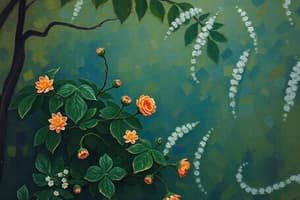Podcast
Questions and Answers
What type of ring does glucose form when it cyclizes?
What type of ring does glucose form when it cyclizes?
- Hexose ring
- Pyranose ring (correct)
- Pentose ring
- Furanose ring
Ketoses can be easily oxidized compared to aldoses.
Ketoses can be easily oxidized compared to aldoses.
False (B)
What distinguishes Alpha(α) and Beta(β) anomers?
What distinguishes Alpha(α) and Beta(β) anomers?
Configuration around the anomeric carbon atom.
The process that forms a glycosidic bond involves the reaction of an anomeric hydroxyl with a hydroxyl from another sugar or compound, producing ______.
The process that forms a glycosidic bond involves the reaction of an anomeric hydroxyl with a hydroxyl from another sugar or compound, producing ______.
Match the following sugar classifications with their descriptions:
Match the following sugar classifications with their descriptions:
Which of the following is an example of a monosaccharide?
Which of the following is an example of a monosaccharide?
Disaccharides consist of more than ten monosaccharide units.
Disaccharides consist of more than ten monosaccharide units.
What is the primary product of photosynthesis in plants?
What is the primary product of photosynthesis in plants?
Carbohydrates are classified into monosaccharides, disaccharides, oligosaccharides, and __________.
Carbohydrates are classified into monosaccharides, disaccharides, oligosaccharides, and __________.
Match the following types of carbohydrates with their descriptions:
Match the following types of carbohydrates with their descriptions:
What is a function of carbohydrates in living organisms?
What is a function of carbohydrates in living organisms?
Diabetes is associated with disorders in carbohydrate metabolism.
Diabetes is associated with disorders in carbohydrate metabolism.
What captures light energy during the photosynthesis process?
What captures light energy during the photosynthesis process?
Which of the following sugars contains four carbon atoms?
Which of the following sugars contains four carbon atoms?
Monosaccharides are non-reducing sugars.
Monosaccharides are non-reducing sugars.
What type of disaccharide is formed from two identical monosaccharide units?
What type of disaccharide is formed from two identical monosaccharide units?
Sucrose is a type of __________ disaccharide.
Sucrose is a type of __________ disaccharide.
Match the type of carbohydrate to its description:
Match the type of carbohydrate to its description:
What structural representation of sugars shows the cyclic form of glucose?
What structural representation of sugars shows the cyclic form of glucose?
All polysaccharides are reducing sugars.
All polysaccharides are reducing sugars.
What is the name of the five-membered ring structure in sugars?
What is the name of the five-membered ring structure in sugars?
Flashcards
Carbohydrates
Carbohydrates
Organic molecules found in nature, consisting of aldehyde or ketone compounds with multiple hydroxyl groups. Their basic molecular formula is (CH2O)n, where n is 3 or more.
Monosaccharides
Monosaccharides
Simplest carbohydrates; cannot be broken down into simpler units.
Disaccharides
Disaccharides
Carbohydrates that produce two monosaccharides upon hydrolysis.
Oligosaccharides
Oligosaccharides
Signup and view all the flashcards
Polysaccharides
Polysaccharides
Signup and view all the flashcards
Photosynthesis
Photosynthesis
Signup and view all the flashcards
Glucose
Glucose
Signup and view all the flashcards
Aldose
Aldose
Signup and view all the flashcards
Ketose
Ketose
Signup and view all the flashcards
Energy Storage (carbohydrates)
Energy Storage (carbohydrates)
Signup and view all the flashcards
Haworth Projections
Haworth Projections
Signup and view all the flashcards
Pyranose Ring
Pyranose Ring
Signup and view all the flashcards
Anomeric Carbon
Anomeric Carbon
Signup and view all the flashcards
Anomers (α and β)
Anomers (α and β)
Signup and view all the flashcards
Sugar Acids
Sugar Acids
Signup and view all the flashcards
Sugar Alcohols
Sugar Alcohols
Signup and view all the flashcards
Deoxy Sugars
Deoxy Sugars
Signup and view all the flashcards
Amino Sugars
Amino Sugars
Signup and view all the flashcards
Glycosidic Bond
Glycosidic Bond
Signup and view all the flashcards
Monosaccharides
Monosaccharides
Signup and view all the flashcards
Aldose
Aldose
Signup and view all the flashcards
Ketose
Ketose
Signup and view all the flashcards
Triose
Triose
Signup and view all the flashcards
Tetrose
Tetrose
Signup and view all the flashcards
Pentose
Pentose
Signup and view all the flashcards
Hexose
Hexose
Signup and view all the flashcards
Disaccharide
Disaccharide
Signup and view all the flashcards
Glycosidic linkage
Glycosidic linkage
Signup and view all the flashcards
Reducing Disaccharide
Reducing Disaccharide
Signup and view all the flashcards
Non-reducing disaccharide
Non-reducing disaccharide
Signup and view all the flashcards
Oligosaccharide
Oligosaccharide
Signup and view all the flashcards
Polysaccharide
Polysaccharide
Signup and view all the flashcards
Homo-polysaccharides
Homo-polysaccharides
Signup and view all the flashcards
Heteropolysaccharides
Heteropolysaccharides
Signup and view all the flashcards
Fischer projection
Fischer projection
Signup and view all the flashcards
Haworth projection
Haworth projection
Signup and view all the flashcards
Study Notes
Introduction to Biochemistry
- Course name: Introductory biochemistry
- Lecturer: Nashwa W. Yassa, PhD
- Institution: Alexandria University, Faculty of Science
Carbohydrates
- Carbohydrates are organic molecules found in nature
- These molecules are aldehyde or ketone compounds with multiple hydroxyl groups.
- The basic molecular formula is (CH₂O)n, where n = 3 or more.
- Carbohydrates are polyhydroxylated compounds with at least 3 carbon atoms and a potentially active carbonyl group (aldehydic or ketonic).
- They can be classified as aldoses (containing an aldehyde group) or ketoses (containing a ketone group)
- Often comprised of polyhydroxy compounds
- Carbohydrates are widespread in both animal and plant tissues.
Where do carbohydrates come from?
- Carbohydrates are produced by photosynthesis in plants.
- Photosynthesis uses light energy, carbon dioxide (CO₂), and water (H₂O) to produce sugars (C₆H₁₂O₆) and oxygen (O₂).
- Cellular respiration in animals and plants uses sugars and oxygen to produce carbon dioxide, water, and energy (ATP).
Process of Photosynthesis
- Sunlight, carbon dioxide, and water are used to create sugars and oxygen by plants.
Structure of Photosynthesis
- The equation for photosynthesis is: 6CO₂ + 6H₂O + light energy → C₆H₁₂O₆ + 6O₂
- This means that 6 molecules of carbon dioxide and 6 molecules of water, reacting with light energy, produce one molecule of glucose and 6 molecules of oxygen.
Importance of Carbohydrates
- Carbohydrates are the most abundant organic molecules in nature.
- They serve many functions in living organisms, most notably as an energy source (forming the majority of dietary calories).
- Also components of nucleic acids, crucial for cell membranes and communication, are key structural elements in plants (e.g, cellulose and lignin) and microorganisms (e.g, murein).
- Issues with their metabolism can lead to diabetes.
Classification of Carbohydrates
- Monosaccharides: simplest carbohydrates (e.g., glucose). They cannot be hydrolyzed into simpler units; the most abundant is D-glucose
- Disaccharides: form 2 molecules of monosaccharides when hydrolyzed. (e.g, maltose, lactose, sucrose)
- Oligosaccharides: form 3 to 10 monosaccharide units when hydrolyzed.
- Polysaccharides: form more than 10 monosaccharide units when hydrolyzed.
Nomenclature of Carbohydrates
- Carbohydrates can be named based on the active group (aldehyde or ketone) and the number of carbon atoms.
- Aldoses contain aldehyde groups; ketoses contain ketone groups.
- The number of carbon atoms determines the prefix (e.g., triose, tetrose, pentose, hexose, heptose).
Monosaccharides
- Aldoses (e.g. glucose) typically have an aldehyde group at one end
- Ketoses (e.g. fructose) usually have a keto group at carbon 2
Disaccharides
- Two monosaccharides covalently joined by a glycosidic linkage.
- Can be classified as homo-disaccharides (two similar units, e.g, Maltose) or hetero disaccharides (two different units, e.g., lactose, sucrose).
Oligosaccharides
- Short chains of 3 to 10 monosaccharides
Polysaccharides
- Long chains of monosaccharides
- e.g Starch, Amylopectin, Cellulose
Structural Representations of Sugars
- Straight-chain (open-chain) formula
- Fisher projection formula
- Haworth projection formula
Cyclic Structure of Sugars
- The cyclic structure of glucose accounts for more of its chemical properties, which includes:
- the reaction of the aldehyde group with a specific alcohol group in the same molecule to form a hemiacetal
- The cyclic structure of glucose can be represented as pyranose and furanose rings
- The alpha and beta forms of glucose differ in the position of the hydroxyl group at carbon 1
Isomers
- Isomers have the same chemical formula but a different arrangement of atoms in the structure
- Optical isomers are mirror images (e.g. D and L forms)
- Epimers differ in the configuration around a single carbon atom.
Anomeric Carbon Atom
- The carbon atom part of the carbonyl group is termed as anomers, a specific form of isomerism in cyclic carbohydrates which differ ONLY in the stereochemistry of this carbon.
- the alpha and beta forms differ only in the stereochemical arrangement around the anomeric carbon
Biologically Important Glucose Derivatives
- Sugar acids, (e.g. gluconic acid, glucuronic acid, glucaric acid)
- Sugar alcohols (e.g., sorbitol, mannitol)
- Deoxy sugars (e.g., deoxyribose)
- Amino sugars (e.g., glucosamine, galactosamine)
Glycosidic Bond
- A covalent bond formed between a cyclic sugar molecule hydroxyl and another sugar or other compound molecule.
- A glycosidic bond is formed when the anomeric carbon of one molecule is bonded to the hydroxyl group of another molecule, releasing water.
Starch
- Starch is made up of amylose and amylopectin
- Composed of chains of glucose monomers joined by glycosidic bonds
- Storage polysaccharide in plants.
Reducing Properties of Monosaccharides
- The ability of monosaccharides to act as reducing agents is due to the presence of a free anomeric carbon atom
- Some monosaccharides can reduce certain oxidizing agents, which is used in laboratory tests like Fehling's.
Properties of Monosaccharides
- Optical isomerism
- Epimerism
- Hemiacetal and hemiketal formation
- L and D forms
- Anomers
- Formation of glycosidic bonds
- Reducing properties
Studying That Suits You
Use AI to generate personalized quizzes and flashcards to suit your learning preferences.
Related Documents
Description
This quiz covers the fundamental concepts of carbohydrates within the introductory biochemistry course. It explores their structure, classification, and roles in living organisms, particularly focusing on their production through photosynthesis and their significance in both plant and animal tissues.




